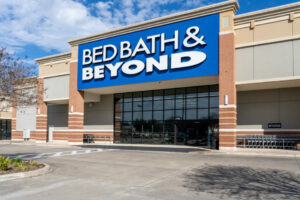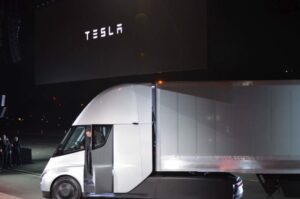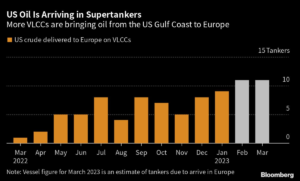
According to Walmart and Amazon, drone deliveries are in our very-near future. Skeptics say it may be a long wait; possibly forever. (After watching this Walmart video, you may agree.) In the meantime, whichever way final-mile delivery is actually achieved, the growth in online shopping means there’s an urgent need to site inventory as close to the consumer as possible. But there’s a problem: Traditional distribution centers tend to be in the middle of nowhere, strategically placed to be both cheap and within reach of multiple population centers.
The reason Walmart can be experimenting with drones and delivery trikes and whatever other H.G. Wells-type future they have in mind for us is that they have huge stores close to lots of people – the retail giant is reckoned to have at least one of its 4,700 stores within 10 miles of 90% of the U.S. population. It’s been relatively easy for them to convert some of that convenient retail space into e-commerce order-fulfillment capacity. Amazon meanwhile has turned its attention to expanding its DCs into downtowns, neighborhoods and suburbs, according to BigRentz.com. Putting them in neighborhoods will enable the company to create what The Dallas Morning News called something akin to “its own UPS.” (It’s already bigger than UPS. And FedEx.)
For the rest of the business community struggling to compete amidst the rise of rapid, direct-to-consumer, smaller shipment demand, the need to grab space close to the shopping public presents challenges. Densely populated areas don’t tend to have a lot of greenfield sites on which to build DCs.
One self-evident solution is to repurpose under-utilized shopping malls as DCs. After all, they tend to include large buildings with multiple loading docks, in locations that provide easy access for (and now to) consumers.
Amazon initially saw the opportunity, but seems to have backed off the idea since. Between 2016 and 2019, it converted around 25 shopping malls into fulfillment centers, according to analysis by Coresight Research, and in 2019 was reportedly in talks with Simon Property Group, the country’s biggest mall owner, to convert bankrupt JCPenney and Sears department stores in a similar way. The deal never materialized.
“There was a surge of interest in this model in 2019, then it went quiet,” explains Bill Thayer, CEO of Fillogic, which converts under-utilized retail space like malls into middle-mile fulfillment and reverse logistics centers so that retailers can chose how they take care of the last mile themselves. Fillogic chooses ones with the right combination of location and facilities, and adds in a new factor – what Thayer calls “channel-free” logistics.
What’s particularly attractive about shopping malls is that they offer the possibility of creating a hybrid facility that combines logistics and fulfillment activities with in-person activities for shoppers. In theory, this serves the needs of what’s typically called omnichannel commerce. But Thayer says the term is outmoded. Omnichannel was created to accommodate a world in which e-commerce could be serviced without physical stores; it was its own, separate universe. But, when e-commerce became a driver of sales volume (and people wanted to return purchases at a greater rate than before), it was necessary to bring it into the “traditional” retail fulfillment environment and infrastructure.
“But channels create walls and integration layers that fail, miserably,” Thayer says. “You have an unstable infrastructure built 30-40 years ago, and now you’ve built something even more unstable on top of it. Retailers try to say [the channels] are different, but they’re not. A SKU is a SKU is a SKU. Get it there fast and efficiently, and make the returns easy. Customers don’t care about omni-channel, especially after the pandemic.” People, he points out, are rapidly regaining interest in an in-person shopping experience, in combination with online.
Converted, or some might say partially rehabilitated, malls can provide a combination of in-person shopping (including returns) with non-shopping offerings such as paintball, sports and other entertainment, as well as food outlets. “Inventory should be close to where the consumers are, where you buy, return, touch it and so on. What better ecosystem than where physical retail is, than shopping malls?” Thayer argues.
The critical fourth “pillar” of the new mall is that it comes designed with logistics thoroughly in mind. Channel-free logistics means building infrastructure where it simply doesn’t matter where stuff came from; it just handles it in the most efficient way possible. Smart use of technology is key, Thayer says. “Retailers are taking WMS systems and trying to apply them in retail stores, and that’s problematic because the merchandise is being touched by people.” For example, in a store, ticket switching, or transferring the price tags or barcodes from a cheaper item to a more expensive one, is a problem WMS systems are not set up to handle. The same goes for robotic automated storage and retrieval systems. “AS/RS is phenomenal in grocery, but it doesn’t work elsewhere. A box of cornflakes is always the same, but a dress is not a dress,” Thayer says.
In short, Thayer is interested in building a logistics world that keeps the reality of consumer habits front and center. “People want to connect, and they want that experiential piece, and that’s great. But they also want to buy digitally and return via Uber.” Fillogic’s model is designed to make that easier, and to thereby save retailers money – the company claims retailers and brands using Fillogic improve service and reduce costs by 30-60%, increase full-price sales by 180% and improve return-to-stock by 50-70%. They say their customers also use five times less warehousing space, which saves 80% on warehousing emissions and 20% on transport emissions.
Thayer says there’s also a significant sustainability angle in just avoiding digging up more fields to create new DCs. “Let’s not keep building these massive buildings in the middle of the country. They have an extremely negative impact on the environment. Let’s use the existing infrastructure more efficiently,” he says.
- SEO Powered Content & PR Distribution. Get Amplified Today.
- PlatoData.Network Vertical Generative Ai. Empower Yourself. Access Here.
- PlatoAiStream. Web3 Intelligence. Knowledge Amplified. Access Here.
- PlatoESG. Carbon, CleanTech, Energy, Environment, Solar, Waste Management. Access Here.
- PlatoHealth. Biotech and Clinical Trials Intelligence. Access Here.
- Source: https://www.supplychainbrain.com/articles/38838-remember-the-mall-now-its-a-fulfillment-center-and-more
- :has
- :is
- :not
- :where
- $UP
- 10
- 2016
- 2019
- 25
- 700
- a
- About
- access
- accommodate
- According
- achieved
- activities
- actually
- Adds
- After
- ago
- akin
- All
- already
- also
- always
- Amazon
- amidst
- an
- analysis
- and
- and infrastructure
- Apply
- ARE
- areas
- Argues
- around
- AS
- At
- attention
- attractive
- Automated
- avoiding
- backed
- bankrupt
- BE
- became
- because
- been
- before
- being
- Better
- between
- Biggest
- Bill
- both
- Box
- brands
- bring
- build
- Building
- built
- business
- but
- buy
- by
- called
- Calls
- came
- CAN
- Capacity
- care
- Center
- Centers
- ceo
- challenges
- channels
- cheap
- cheaper
- chose
- claims
- Close
- combination
- combines
- comes
- Commerce
- community
- company
- compete
- Connect
- consumer
- Consumers
- Convenient
- convert
- converted
- Costs
- could
- country
- create
- created
- Creating
- critical
- Customers
- Dallas
- deal
- delivery
- Demand
- Department
- designed
- different
- digitally
- distribution
- Doesn’t
- Dont
- driver
- Drones
- e-commerce
- easier
- easy
- ecosystem
- efficient
- efficiently
- elsewhere
- Emissions
- enable
- Entertainment
- Environment
- especially
- Even
- example
- existing
- expanding
- expensive
- experience
- experiential
- Explains
- extremely
- facilities
- Facility
- factor
- FAIL
- FAST
- fedex
- Fields
- five
- food
- For
- forever
- Fourth
- from
- front
- fulfillment
- future
- get
- giant
- Goes
- grab
- great
- greater
- greenfield
- grocery
- Group
- Growth
- handle
- Handles
- Have
- he
- How
- HTTPS
- huge
- Hybrid
- ID
- idea
- Impact
- improve
- in
- include
- Including
- Increase
- Infrastructure
- initially
- integration
- interest
- interested
- into
- inventory
- IT
- ITS
- jpg
- just
- Keep
- Key
- large
- Last
- last mile
- layers
- least
- less
- like
- loading
- location
- locations
- logistics
- Long
- Lot
- lots
- make
- massive
- Matter
- May..
- means
- meantime
- Meanwhile
- merchandise
- Middle
- might
- mind
- model
- money
- more
- morning
- most
- multiple
- necessary
- Need
- needs
- negative
- never
- New
- now
- of
- off
- offer
- Offerings
- Omni-Channel
- omnichannel
- on
- ONE
- ones
- online
- online shopping
- Opportunity
- or
- Other
- our
- out
- Outlets
- own
- owner
- pandemic
- particularly
- People
- phenomenal
- physical
- physical retail
- piece
- placed
- plato
- Plato Data Intelligence
- PlatoData
- points
- populated
- population
- possibility
- possible
- possibly
- presents
- price
- Problem
- property
- provide
- public
- purchases
- Putting
- rapid
- rapidly
- Rate
- reach
- Reality
- reason
- reduce
- relatively
- remember
- reportedly
- research
- REST
- retail
- retailers
- return
- returns
- reverse
- right
- Rise
- s
- sales
- Sales Volume
- same
- Save
- saw
- say
- says
- seems
- separate
- serves
- service
- set
- Shoppers
- Shopping
- Short
- should
- significant
- similar
- Simon
- simply
- since
- site
- Sites
- Skeptics
- smaller
- smart
- So
- solution
- some
- something
- Space
- Sports
- storage
- store
- stores
- Strategically
- Struggling
- such
- surge
- Sustainability
- Systems
- Take
- taking
- Talks
- Technology
- tend
- term
- than
- that
- The
- their
- Them
- themselves
- then
- theory
- There.
- thereby
- These
- they
- this
- thoroughly
- ticket
- times
- to
- top
- touch
- touched
- traditional
- Transferring
- transport
- try
- trying
- Turned
- typically
- u.s.
- Uber
- Universe
- UPS
- urgent
- us
- use
- using
- via
- volume
- wait
- Walmart
- want
- wanted
- Warehousing
- was
- watching
- Way..
- WELL
- went
- What
- whatever
- when
- which
- will
- with
- within
- without
- WMS
- Work
- world
- years
- you
- zephyrnet












